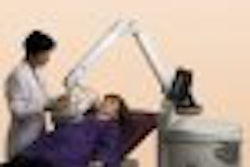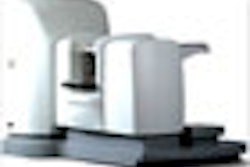CHICAGO - Fifty percent or more of the negative breast cancer biopsies performed in the U.S. might be eliminated using ultrasound "elasticity" testing, according to a preliminary study presented at the 2006 RSNA meeting.
In more than 80% of biopsy cases, the lesions are benign but the patient suffers expenses and anxiety until the negative result comes back, and she is still left with a scar, said Dr. Richard Barr, a professor of radiology at Northeastern Ohio Universities College of Medicine in Rootstown, Ohio.
With ultrasound elasticity testing, patients undergo a standard ultrasound test to visualize the lesion seen on mammography. Then a second ultrasound exam that takes about two additional minutes is performed, which highlights certain characteristics of the lesion, including its size and how much it move or stretches. If the lesion measurement in the second test is larger than that seen in the first exam, the likelihood is that the lesion is cancerous, Barr explained.
In a pilot study of 123 breast lesions in 80 women, all of whom underwent biopsy, Barr and colleagues used elasticity testing with a modified Elegra or Antares ultrasound system and software (Siemens Medical Solutions, Malvern, PA).
The ability to discern differences in the two images is simple, Barr said. "We don't know why, but the image of the lump gets larger when we apply the elasticity software if that lump is a cancer. Similarly, the image of a noncancerous lesion gets smaller with the elasticity software," he said.
The elasticity test identified 17 of 17 cancers and correctly identified 105 of 106 other lumps as benign with one false positive, for 100% sensitivity and 99% specificity, Barr said.
The test is not ready for prime time, noted Dr. Ellen Mendelson, a professor of radiology at Northwestern Memorial Hospital in Chicago. "However, this is very promising and could eliminate the need for a lot of biopsies. It definitely is worth a large, prospective clinical trial," she said, adding that other manufacturers are working on similar devices.
Barr said that such a trial is being put together at multiple sites. Again, all the women in the study will undergo biopsy to see if the predictive values seen in the small trial can be replicated on a larger scale. He predicted it would be a few years before doctors would be willing to use the elasticity test as the final word on whether a biopsy should be performed.
"Our ability to find lesions in the breast has increased significantly over the last 10 years, but at the expense of an increased number of biopsies," Barr said. "Even though most of these lumps are benign -- which is what we found in our pilot study -- they still cause considerable concern and anxiety in the woman and add to medical resource expenditures." A biopsy can cost from $500 to $1,000, and 75% to 80% prove to be unneeded, he noted.
"This technique could significantly reduce the number of biopsies and increase the confidence of women that a detected lesion is truly benign," Barr said. "If the use of the ultrasound elasticity test is extended into general treatment, I think we would be able to make at least half the biopsies being preformed for breast cancer unnecessary."
By Edward Susman
AuntMinnie.com contributing writer
November 28, 2006
Related Reading
Streaming US, elastography US give clearer picture of breast lesions, June 16, 2006
Breast surgeon expresses reservations about screening US, May 13, 2006
Auto breast US handily spots lesions in early study, January 13, 2006
Compression US plus computer analysis classifies solid breast masses, September 7, 2005
US elastography shows promise as mammography adjunct, March 5, 2005
Copyright © 2006 AuntMinnie.com



















